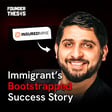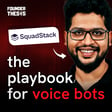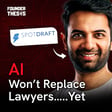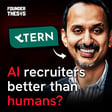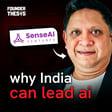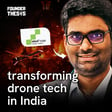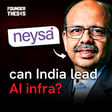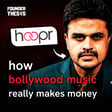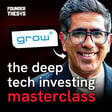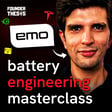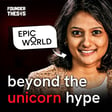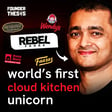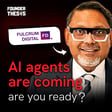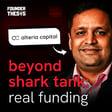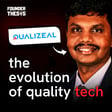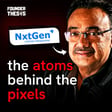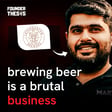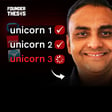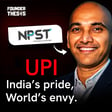Introduction to Seeram Kannan and Roadmatic
00:00:00
Speaker
Hey, my name is Seeram Kannan. I'm the founder and CEO of Roadmatic. We are in the business of people's transportation.
00:00:18
Speaker
Have you heard of the travelling salesman problem? Imagine that a travelling salesman needs to visit a certain number of cities and then return to the origin point. This is a notoriously complex problem for computer science to solve and more the number of cities there are, the exponentially harder this problem becomes.
Kannan's Journey into Entrepreneurship
00:00:36
Speaker
but some people are attracted to exponentially harder problems the way bees are attracted to honey. And one such founder is Sriram Kanan. Sriram is a hands-on computer scientist who was solving complex security problems for Texas Instruments when he became an accidental entrepreneur. 17 years later, he is still consistently looking for harder and harder problems to solve as an entrepreneur.
00:01:00
Speaker
The problem Kanan is currently solving is the problem of employee transport. How do you build a platform that allows companies to provide convenient, compliant and safe transportation to their employees while minimizing the number of vehicles needed to deliver this?
Navigating Career Transitions and Market Challenges
00:01:15
Speaker
In this freewheeling conversation with your host Akshay Dak, Kanan shares some amazing insights and stories about his amazing journey of solving problems at a scale as an entrepreneur. ah Let's dive in.
00:01:36
Speaker
Siram, I'd love to understand what was the journey of becoming an entrepreneur. So it was, ah in a lot of ways, and practically a forced entrepreneurship on me. So let me give you a quick background on that. So I was a happy camper with a nice degree you know working for a company as big as Texas Instruments, which I am still in love with. um I had worked there for about seven and a half years. um the last two of which are I had been working on 3G platforms as part of TH Japan. I was working on ah the third generation of chipsets, yes, but as you know it ah a typical mobile phone has both the 3G side and the apps processor. um My ah work was on the apps processor for sure.
00:02:24
Speaker
um because I was a security architect in a lot of ways and designing security chipsets. So yes, this was a combined chip set, but the the activity that I was involved with was in security, securing the mobile phone. We call it DRM, you know, digital rights management, a lot of things, right? So predominantly my work was found called SOC, system on chip, what a Snapdragon processor is. So this was a competitor to Snapdragon. Snapdragon came a little later, but yes, I'm talking about 2005 timeframe, but yes, it's in a lot of ways a competitor to TI, yes. Right. So you had a chance to join a, like a sister company of TI in Japan to work on the software, DRM, other things.
00:03:10
Speaker
Yeah, so it started that way. But you know I came back to India and you know I was in the process of setting it up when we were doing the project. But um what also happened was that there was a lot of, I think, politics and whatnot, right? That whatever we planned to do in the beginning was not really relevant within the next one or two years' time because the landscape changed. You see the androids, iPhones. See, I'm talking about that era when Nokia, BlackBerry, you understand the transformation that was happening in the market. So this is basically that time. In fact, I still remember one of the operating systems that I launched at that time was what on on a TI hardware is what we know called Android. right I'm coming from that
Innovations in Mobile App Development
00:03:51
Speaker
today So there was this experimental platform from 2006-07 that we used to play around. but So yeah, I mean, a lot of history to this whole thing. But yes, I started this company, which the name still stands as Nevada systems, which is the original name of the company. Nevada is a private limited. that It essentially stands for security. like These are characters in Mahabharata called Kavache Nivadas, where this means impenetrable coat of armor. That's the original name of the company. Deep roots in security, safety, kind of for connotation. And this was a TI subsidiary.
00:04:26
Speaker
Not a subsidiary, it was a third party, it was a wholly independent company, but a third party partner with an MOU to supply technology. Oh, TI was a customer. Yes, TI's customers were my customers. People who make mobile phones would use their TI's hardware and my software. And you owned the company? just yeah Yeah, it was a single founder ah practically company at that time. I was back in Bangalore in 2007 setting this up. And we were doing the project and you know we added high quality cameras at that time, 8 megapixel was not heard of. you know I'm talking 2007. So I was into development of so you know what we call DM processors. We used to do the
00:05:14
Speaker
you know security all of these are kind of more or less in the in a similar space right. They may sound different outside but internally the architecture mechanics more or less you know the electronics more or less the same so that's what I was working on in the beginning. I'm still a little confused here. Is this a business that TI incubated and gave you a chance to run and let you own it? Or is it that you spotted an opportunity and decided to quit TI and you told TI that I want to be your vendor. I can help you here. No, it was a golden handshake from the other side. I did not i did not even know what an entrepreneurship was.
00:05:50
Speaker
Okay. okay but yeah have that This is a good salary, you know, a lot of travel. Yes. so and There was absolutely, i it's not in my blood to be an entrepreneur. Let's call it that it's a, it's a kind of a bummer for you, but that's where it was, right? Many people had to catch all me into making this happen. Okay. I was forced. Okay. the idea so youre up Capital like to know. So I even hear my manager that said, you know, uh, you know, you can always come back in three months. If this doesn't work out, right? That was 17. Yeah. Okay.
00:06:27
Speaker
Okay. So that's not how things work, but I was naive in accepting that. I mean, if not, I would have been much happier continuing on in a company like TI for sure. Right. no yeah Okay. Yeah. Okay. Interesting. Okay. So how many years did you run that business? How did you, what did you scale it up to? What kind of revenues were you doing? What kind of team size? So it did we started the development and we started engaging with clients of course but quickly the whole thing fizzled within a year because um again like I said there was a big transformational change that was happening. The androids and iPhones coming in, the market share ah for that particular teacher that I was working on, the DRM was also kind of getting irrelevant if you understand. right There was no need
Kannan's Contribution to Teleophthalmology
00:07:11
Speaker
It's an open market now, right? So there were, there were a lot of factors that did not work in the the the favor of this, right? So it was basically what we started off was relevant for maybe I would say one, one and a half years of consulting work, but, uh, quickly turn into a generic consultation work, not really to chips, air you know, security, but you understand how consulting works and you start getting with Nick. That's why I said there was security. roads and Whatever works. Camera. Yeah. How do I develop camera? And then this and that you are like, uh, Ronin, right? Just, just roaming around and consulting and talking to people. So that's how it was.
00:07:47
Speaker
Okay. Interesting. You use the term Ronin, which comes from Japanese culture of a samurai without two years. I've been there. Okay. Okay. Okay. So how long did you continue that business? It was there for, um I would say I'm still continuing in the sense that he was not shut down officially. but So it is the company name. You never went back to TI. You just continued. That company continues. ah There is another job in between the chief innovation officer at I2I. Yes. Yes. So I was talking with TI, blah, blah, blah. So that thing happened. And I also had the opportunity to work with a good friend and my very big senior, Mr. Shyam Banerjee, who runs I2I tele solutions. So like I said, da when I was running, I had a lot of free time. And you know, funding was it was not a problem because there was a little bit of so savings and all that.
00:08:43
Speaker
so um um Also, the way it works, I actually, believe it or not, retired at the age of 32 from dia Japan. That's how it worked. but Okay. So I actually got retirement money also. ah okay So yeah, so I had a bit of cash. Let's call it that. And when it came back and I was doing this interactions, there was also a charm who wanted some little bit of help in a mobile app ah to be developed. So I kind of helped out with that. I had Novata, but we were also, like I said, consulting. I was consulting with multiple companies wanting help on mobile. Again, if you rewind back to the 2007, 2009, the mobile phones you would know are the Nokia, you know, the the little 3310s, not the smartphones. They were not there at that time.
00:09:30
Speaker
And I had the privilege of developing those from inside of K9, the full stack. So I was helping a bunch of companies who were developing for the upcoming smartphones, apps for media, blah, blah, blah. So I was helping out the I2A also for developing this um very interesting and emotional project called teleophthalmology, right? So it has its own track. So ah in the year 2009, I had the big opportunity of working with some very eminent doctors through eye to eye to develop a mobile phone based screening of patients about looking at medical images and so on.
00:10:11
Speaker
So a big opportunity for me, I mean, yeah, I had a lot of cycles to spend, you know, preview cycles to spend. So I developed, I think it's considered the world's first um medical app. If I'm not mistaken, that could do imaging. And the first batch of i iPhones, believe it or not, was shipped to us for testing it out because I had developed it on an eye touch, right? wow So it was helpful in this area called ROP, retinopathy of prematurity, which effectively prevents so in our infant blindness. If there is a particular condition which you can detect within the first to two or three weeks and you can actually completely cure their blindness if you spot it through images, if you don't, they go permanently blank,
Commercialization and Expansion of the "Where Are You" App
00:10:51
Speaker
right? ah ROP. So I had the privilege of working with very eminent doctors from Narayan and Netrelay and so on through this outfit. So it was a very interesting two years that I spent ah developing this stuff, which is still a very good you know activity that I have been part of.
00:11:06
Speaker
Um, yeah, so I, I am particularly proud of, you know, having developed this, which is, you know, very directly, you can see it on the ground, right? There there is a vehicle that with a very large red camera, retinal camera goes around collecting images. Doctors don't have to travel all the way. So the true power of mobility comes up when you develop something like this, right? The doctor could have his iPhone, you know, diagnose images, probably several hundreds more than what he could do by traveling to these rural areas. So that was a big opportunity. I spent a good two years working on that. Okay. So what next? So at that time um I was also working on a pet project of mine, a very personal project called where are you?
00:11:51
Speaker
Right. I'm popularly known for that also from 10 years back. Where are you stands for the third most often repeated question. Hello, how are you and where are you? Right. So where are you? We are here you is actually where are you? Right. A short form. Um, so I was, I developed a solution for tracking a mobile phone. Interestingly, without GPRS and the GPS, no data required, no GPS required, just using cell tower positioning. right The use case was to track my parents who used to travel every few weeks from Chennai to Bangalore and back. The train arrives at 3.34 am. m You have to hustle and bustle. Have you boarded? Have you reached here? Have you reached there? For a train that reaches 3.30, that's all not required because it's a five-minute drive from my home.
00:12:38
Speaker
So I developed a quick app that could, uh, when the phone reaches white fee, which is 10 minutes away from care. per station It will send an SMS to me. The phone will autonomously do that. No GPS required. No data required. Just SMS would do. I call my parents saying, you know, Hey, you are about to reach, please wake up. Right. but So it was a very, and then I started diving. So no hustle, bustle, no hurry, buddy. You don't need too much accuracy, right? You greased whitefield station. Good enough. Right. So I developed a very approximate to the extent of about half a kilometer maximum. activity I mean, uh, scenario.
00:13:15
Speaker
um This was a Java app to be, there was no Android at that time. Okay. So it was personal, but then when the Android phones came up, but yes, I developed it first for Blackberry, we had a partnership. Then I developed it on Android, you know, the story goes on like that. So wherever you was quite popular at that time, many know many clients we had, and you could track say cell phones for natural features, sense force tracking. So my first product was with cell tower company. So the interesting thing is you have customers who are sell cell phone, or you know, network operators, their sales guys are being tracked using their own SIM cards, their own network, their own supplied phones, but the technology is mine. well Right. So it was very interesting how we pulled that off. No OEM support, no network support, but you could track a phone. So it was quite revolutionary for its time.
00:14:06
Speaker
And this was, I'm assuming monetized through businesses, right? Individuals wouldn't be paying for this. Yes, for a per sales guy or per asset, right? We had a gold traffic being tracked for personal safety, whole bunch of applications got built around a fundamental tracking subsystem, right? So that is how it was. Again, basically hacking into the fact that I knew how mobile phones worked. It used to be a fairly big market of tracking ah in that 2010 to 2015 era. This was a fairly large opportunity.
00:14:42
Speaker
um why Why didn't you just double down on it and build up on top of tracking? Today, there are companies which have tracking and location as a base layer, but on top of that, they do a lot of value ads. ah like Uber is an example of that, right? so So why didn't you consider just building on top of that location API in a way, if I can use that term? me We used
Founding of Yantra and Focus on Transportation Safety
00:15:09
Speaker
what we call last API in the beginning. we launch after Soon after launching mobile phone, natural thing is to launch a last API, location asset services API. This was in 2010. We actually launched one. and It was
00:15:23
Speaker
Definitely we had demonstrated it to a whole bunch of, I mean, there is no limit to the number of companies or number, you know, genre. We were doing that. We were quite successful. I would say that. And one of these conversations led to us to develop a tracking device because phones can get tend to get misplaced. You know, you can switch off. There are a few use cases where they said, you know, we actually need a small device that could do the job because we want to track assets, not a human being. So at that time, ah interestingly with another friend from TI, I actually developed a Yantra, a small, very tiny 65 gram tracking device. Why is it called Yantra? It stands for yet another tracking device. There were so many tracking devices in the market.
00:16:06
Speaker
A mobile phone ad becomes a do device, so we call it the Yantra, which is a play on the fact that it's a device, ah but it's yet another tracking device, Yantra. So it was quite popular, and the one of the businesses where it got most adopted was in this transportation space. People transport for safety. Because if you date back to 2011, there were a lot of safety issues around the employee transport that were happening at that time. ah Corporates are very concerned about their safety. So that is what led me to develop Yantra to be a panic button plus the tracking device plus RFID to let employees you know board and get out of a car by just swiping a card was the first hardware innovation that we launched with our first client in 2012-13 timeframe.
00:16:53
Speaker
Right? Then what happens is now coming back to your question, why not continue with that? So um ah tracking is good. You track, you you monetize it for asset being track. There's a very good model still very relevant. But what was happening was the excitement from this employee transportation space was getting much, much bigger for us because for the same kind of investment that one would do in a device because nobody buys
Formation and Evolution of Routematic
00:17:18
Speaker
devices, right? Usually they want you to roll it in. they be If there are four employees in a single car, it is possible now to monetize on a per employee or ah you know the values for an employee, not a device. So I made a very strong decision to stick to ah not the device, but the asset, the payload being tracked. And hence, Routematic was formed. And that had its it we had our own ah way of doing things built in workflows where we truly went from last API
00:17:48
Speaker
which is like a platform, my horizontal to route magic, which is a pure vertical. So we, in fact, internally, the tracking system continues to be where are you, right? I have programmers working on where are you because tracking is an integral part of it, but there was a time when the number of leads, you know, the kind of business we were generating was so much that we had to, as a management team, sit down and decide one way or the other. It was a no brainer. ETS was supplying 95% of my revenue suddenly. because the need for it was much, much more than a regular tracking device. Going vertical was a decision we took in 2014-15 timeframe. Interesting. ETS means employee transportation system. Yes. Employee transport system. Okay. Employee transport system. Okay.
00:18:38
Speaker
and ah This, like you would be selling to, for example, an Accenture, which would have thousands of people traveling on a daily basis, an Accenture would pay you and in return they would yeah get what, like what what would they get? They would get alerts if there was a deviation from rules.
00:18:57
Speaker
That's what we thought, but it was it's a much, much more complex framework than that, as we figured out. And as a trained computer scientist, I go after complexity. What do you call computational complexity? The more complex it is, the more I be heuristics. So that's what I am driven by, personally. There are regular algorithms, and there are AI and heuristics-driven algorithms. i My passion would be to attack problems of a fairly complex nature. Typically, we call these NP hard problems in computing. So that's what I go after. Something as simple as when you look at it from outside, people have to people from the same area have to go in a single car. I mean, how complex can that be? right I am an active coder. This is my 26, 27th year and I'm still coding for that.
00:19:40
Speaker
So, you can imagine what what level of complexity. From the outside, it looks simple, but it is actually not. It's an ERP, it has to spread its tentacles into the corporate data. You know you have to be that level of safety and security compliances. There are lines at stake. You are on on the road, moving, security guard, driver. The ecosystem is very, very, very complex. yeah For a rider, they just get into a car as instructed and they go home. But the kind of machinery that happens and it is one level of complexity more than e-commerce where goods are transferred because they don't worry about comfort of what you are traveling away. You can worry about maybe cold to chain or something where some temperature has to be maintained. But here the temperature sensor is on multiple other categories for a human.
00:20:28
Speaker
So, I was very intrigued by how this was operating and I wanted to really jump in and you know it's a problem worth solving. This is what I continue to say even to my new recruits right. The impact that you are making you don't it is not virtual you just open the window and you will see it. You will see branded cars, you will see people talking about it. So it is a very tangible and immediate. Imagine I was into chipset and you know algorithms in a very different world, but here we are. It's it's an ops intensive, yes, but a huge amount of technology is involved in running something like this. So I still tell my people just open the window and you'll see the impact.
00:21:08
Speaker
For the past time, I still go to the outer ring road near my home and watch cats travel and count the frequency of one of our cars that comes by. So it's it's an interesting piece of work to do. I want to understand this through the journey. ah You told me in 2015, when you had multiple offerings on top of last, you realized that the biggest offering that got traction was the employee transportation. yeah yeah Can you describe to me what was the product then in 2015 that you were selling, which you saw was the most popular product and then the journey of ah building on top of it and you know to where you are today?
00:21:54
Speaker
Very simply put its leaf on a reverse stream, right? That's that's it. yeah I am not a transport expert. I don't pretend to know how her transport is. I'm a ticket. So that's the premise. So we had a tracking solution. We took it to this market and they said, tracking is straight, but we need to map your tracking device to these bunch of employees. I need a piece of software. I said, okay, took a couple of weeks to develop one. It's not like hey I have a different way of looking at this. No. but Right. Sounded interesting. You know, spend a couple of weeks, then they come back and say, okay, this is great. But you know, these people are actually getting routed. So I sat down and understood how these processes work one by one.
00:22:35
Speaker
So the market with a techie like me and my team was able to ah get this out of us. So I wouldn't take credit for building something, you know, where we came up with the vision, nothing like that, but driven by complexity. I like complexity to be solved for and worth solving for where our time is valuable. So it has been drawing us ever since and continues to do so, right? We started with simple stuff that, but now we are trying to handle electric vehicles to the most optimal level, right? It's a never-ending exercise, right? Every day is an existential ah crisis because the next new thing is going to hit your market soon. ah Very interesting. You have to be very dynamic and adaptable to make something like this happen.
00:23:18
Speaker
So version one, track the vehicle is what you sold to a company. So the company said the company would have got some sort of a dashboard where they could see the real-time location. And yeah probably there would be like a history which are in geot history of geotags like here, here. At 10.12, the car was here. At 10.15, the car was here. At 10.20, the car was here. Something like that. So and then they told you that we want not a vehicle-based tracking, but an employee-based tracking. yeah ah And this is when you decided, okay, I need to figure out which employees in which vehicle can and then show it based on employee, not based on vehicle. You
Transition from Hardware to Software Solutions
00:23:58
Speaker
upload an Excel sheet of this mapping and then you get bored and you're a, you're a ticky. You want to solve for that by having a web UI piece of mobile app. So that's how it formed. So they would give you a record. They won't say.
00:24:12
Speaker
They won't give you a requirement. They'll just give a dream, right? So I strongly believe in solving a problem ah in its full glory. This is what I tell my engineer. Don't put your constraints in the beginning saying, given that we have all these constraints, what can be developed? That's the wrong way to approach a problem, right? Let the guy speak, let him, let him come up with asking for sun and moon and tell them why. potentially it may not be possible, but let's not stop him from even giving a requirement, right? So that's how I always so continue and preach that within the org, which is, I see techies coming in. Oh, if you use this framework, we are restricted. No, let the guy talk, right? So this is how it has always been. al Yes, they would talk about somehow mapping it, and then we would propose, no, it's better to do it on a mobile phone or a web. You know, they wouldn't be able to articulate back-end and front-end and do node and all that, right? That's how we've got built.
00:25:01
Speaker
Yeah, and a guy who and listens to the requirements and translating the software. And so till 2015, I'm assuming this would have been hardware plus software. You would have been installing a hardware in the vehicle and before smartphones were strong enough. So when did it become from hardware software to only software? Yeah, so what happened then was, this was all good and everything is a Disneyland for some time, but then you scale, right? You become restricted on your own solution because you are forced to give a piece of hardware read together. Typical car already has some other tracking device and it's insane to try to push yours as the second and third half drain of the battery, you understand the problem, right?
00:25:43
Speaker
It's okay with two, three clients who are only working with you. It's okay, but when market vehicles come, they come. I mean, you have to attach them in the next two minutes, right? So the requirement then was to open your system to any tracking tool device. The client has decided which is the best tracking for them. OEM has the wire, who am I to say, no, you should stick to mine, right? So we stopped selling Yantra devices in 2016 itself. thing, we are open to integrity, so we opened an IoT platform push and pull, oh you know, happy to send, you know, let's agree on an API key and start sending the data, right. That immediately opened the entire market to us, right. So, we said some customers still would want our device, but it is one of the third party components and not really, right, because we are always looking for what, and like I said, if I put a constraint of yes, my device has to be there, we would have been a very different company.
00:26:36
Speaker
right The end vision is not to sell devices. The end vision is to solve this problem. At scale, you solve it by opening your platform um on an IoT basis, which is what we turned out ah to be doing at that time. so we stop the You were doing quite well. The devices were doing very well, but we stopped manufacturing them just to open the network for more ah devices to participate. And at this stage, 2016, when you stopped the devices, uh, your solution was what, like, uh, a real time tracking, which you can log in and see. um and of this full load dropmatic At itself, Robematic could do roster ah management, uh, route planning.
00:27:18
Speaker
tracking, vendor management, SMS and IVR ah flow. but The whole thing, version one was already built and doing quite well at that time. Tracking was one of the five components inside. Interesting. So what you started selling to companies then is not an employee safety, tracking for employee safety, but a SaaS solution to manage employee transportation, where you can manage your vendors and also track your employees and also decide who goes into what vehicle at what time and send them a reminder that your vehicle is reaching your stop in five minutes. ah So that whole full stack SaaS solution to
00:28:00
Speaker
ah for a company to manage employee transportation was what you started selling. Correct, correct. Okay. To go fully digital. problem annual basis Okay. Yeah, it will be per employee per month. So you could really obviously most of the employees will be registered on the platform. That's not what we charge for. They should have taken at least one or two trips in a month, right? So that's how, I mean, an active user in a month is a chargeable user. That's what we went by. How much per user? Typically one to two dollars. Typically, there there are many configurations on spend, et cetera, like SMS, IVR. There are a few transactional items if you ask, so it will vary between 90 to 150 rupees, let's say, based on the configuration.
00:28:44
Speaker
Okay. And this would be like a high margin revenue for you, right? Because it's only software. You're not doing any ops. Cloud hosting and Google maps and nothing else, right? Right. there no yeah right The ops is still managed by the company. fantastic so customer success team for implementation is all you need and the engineering team. We were, we have always been a very lean engineering team, right? And I actually take pride in that. So, I mean, if you according to me, this is not a thousand engineer problem. This is a two, three scientists problem, but there's a big difference. No, amazing. That's a good insight. Okay. So this is like a low operations, high margin revenue that you're getting. Uh,
00:29:30
Speaker
But eventually you decided to not sell a software solution to companies that they will use to manage on their own, but you told them, leave this headache to me. I will manage your employee transportation. You don't have to work with vendors and sign agreements with multiple vendors and then manage them and manage the SLAs. All of that is my headache. I am your one single vendor. Why make that choice? Again, a golden handshake. ah Again, about the matching wound I don't take the but ah credit for that. so i why we were selling So I'll tell you there is an intermediate ah step to that. The software is so good. I mean, yeah it is a piece of tech, right? it's It's brilliant in terms of how you do route planning. Then you do route planning within a few seconds, not a few hours manually.
00:30:15
Speaker
Your cutoffs could be as close to the shift, right? I mean, there's a lot of things that you can derive. Your operations are on an hourly basis can now become minute by minute, you know, a lot of operational benefits to that. But the you need trained manpower to run this, right? You need managers who could understand and harness the full power of the tool. Right. The tool can de deliver so much, but you still need to, you need the man behind the wheel. Many of my clients started saying, why don't, would you, would it be possible for you to actually run this thing for us? Right. So that is how as an intermediate step, we started running a little bit of, you know, just the routing part or just the help desk and all that. And as we did that in 2018, things were very smooth, right? We were highly profitable, good. It was all that tick mark, right? In 2018 top line. It was something like, ah I would say 20, 30, 25 crores per annum or something like that, roughly. I have to check my records. um So that is where we were. But then I started doing my simulation because what's next, right? You always think, okay, this is a solved problem at least now, or what next?
00:31:23
Speaker
I did a quick simulation with my team and I found out that, you know, there is a lot of value that we can deliver to the driver. See today we have been facing ah the demand side, the customers wanting, attracting, you know, that's one side of the story, but a customer's spend and transport is 90-95% in demand. transporters right the drivers, the vendor ecosystem and so on. I wanted to see what we could do and a very simple, you not very complicated, very simple simulation told us that where there were 100 drivers can be reduced to 75 drivers, vehicles, not drivers, but vehicles. They utilize this, right? So the problem is there are millions and millions of trips to be fulfilled, enough number of drivers, but there's still a problem.
AI and Predictive Fleet Management
00:32:12
Speaker
right Because, the drivers are their own salesperson for every trip. Unfortunately, you cannot engage, companies are not going to specialize in transport and driver management. rate They want transport. That is the problem statement. is compliance 100% on 95 on-time departure 99 and this cost per trip of so many rupees per trip that that's the problem yeah everything else that they were trying to do in the tool as features is to achieve these three if you achieve these three there's no tool required
00:32:43
Speaker
The tool has done its job. So rather than saying send an SMS in this condition or this that some 2000 requirements is basically just to achieve these three. I wanted to take a with my team wanted to see how we can solve this problem is to solve the problem on the apply side. Again, it was not really a business model or anything at that time. 100 has to come down to 75. And this is not like a what we call no free lunch. I mean, this cannot happen without hurting somebody. actually it hurts redundancy right, everybody getting mediocre making 100 people making money, if 75 people make the same amount of money it is good right, as I get somewhat as quickly you get to net a little bit more. So, some model have to be built around that, but effectively
00:33:28
Speaker
The efficiency of the system is in efficient rotation of the gaps. So we launched a roadmap to gaps along with a few of our clients, ah most notably Infosys Pune, where we said we will try to achieve better utilization for the benefit of everybody. and we will be the man in the money. So in a lot of ways we are the, I would say a flip cut of transport, a marketplace where demand keeps coming and they want what they want. Suppliers know what to build or you know how to drive and somebody has to just look at this efficiency of operations, right? It can only be done by a city.
00:34:05
Speaker
not by a company because the average trips in a day by a single company may not be able to give five, six trips in a day. They might be able to give one and a half to somebody else has to come in. So you truly need a marketplace to aggregate all this demand and allocated to the city's resources. So city's trips need to come into a platform and the city's resources have to solve for it, not really come. It's like a VPN otherwise said you are, there is a cost to it. Right? This is what we launched in 2018 and it has worked out really well. So we source, we talked to drivers on, we buy drivers time, 12 hours, 14 hours, right? And I will promise my payment to you this much, right? Whether I am able to achieve this or not, you could, you can now understand that it's not possible for them to, why do drivers switch between Ola, Uber, Raukmati, you know, all sorts of act. Why do they do that? No single use case or no single company is going to solve your problem.
00:35:02
Speaker
You need to aggregate the demand, you need to aggregate supply, disjoin from each other, but tie it through an AI stack. What is it required for you is to know how tomorrow is going to look like and aggregate supply for that. So, we have an AI stack ah interestingly built around ah ah reinforcement learning, right the chess playing machines use that. Your next move, this is not like a, what we call a regression problem or a supervised and supervised. It is a self-learn system. So you try to run simulation. Yeah. yeah let Let me ask you to pause a bit. Okay. I want to do a little bit of a recap before we come to the AI system that you're using.
00:35:43
Speaker
When a company is using only the SaaS product, they are using 100 cabs to transfer, let's say, hypothetically 500 employees. ah Part of the reason for that is that maybe a cab in the morning goes from point A to point B, and then it stays in point B till evening, and then in the evening it goes back from point B to point A. Whereas if you are able to aggregate this demand from multiple companies and maybe when the cab has done the point A to point B route, after that it might find some way to go from point B to point C and so on. So so therefore that cab gets right throughout the day instead of just those lumpy morning, evening hours, it it gets some work throughout the day. Thereby instead of having 100 cabs being used, only 75 cabs can do and all of them earn more.
00:36:30
Speaker
and The only way to do that is if you are able to get demand from multiple companies so that you are able to give that one single cab more business. So then your pitch to a company was that look at me as a Ola for business or an over for business. And I will charge you on a per employee based on the pickup and drop, maybe some kilometer, some sort of calculation might be there. I'll charge you on a per employee basis. And then you have to figure out ah the most optimal way to route it so that you are able to do not one employee in a cab, but five employees in a cab, for example, so that it is a profitable ride for you.
00:37:10
Speaker
Correct. So, and when a client optimizes for stem themselves, they have to design supply for their peak and hold it throughout the day. Correct. Right. You have a shift 8am login of 500 vehicle requirement, which is the largest, the next one will be 300. What do you do with the remaining 200? Right. So I am saying I bring some other company, you know what you, you will, let's engage on a triple level like arrangement between us. And you know I will make sure that the vehicle is rotated and all that. so But understand one thing. It is not just the cost. Cost is one of the factors. ah Compliance of 100%, the driver and vehicle paper is very, very paramount, ah you know extremely critical for the corporate. right You cannot compromise on compliance. So our system automatically delists those with a 30-day notice. it It is impossible to run non-compliant vehicles on the system.
00:38:01
Speaker
Second one is on time learning we are in a DPO, KPO. you know Timing is very critical. The cost of missing your seat is much higher than the cost of your car. Let's agree on that. right So the the timeliness, OTA, OTD metrics are the golden metrics in this market. Then comes at for this premium service, what is the cost? Right? So these are the, this is the holy trinity. If you simply go after cost, your compliances will suffer because last minute you ought to bring, you know, 20% of them could be not having paper. There are a lot of things, right? This is the holy trinity of trying to achieve all three without a compromise. Only a shared system can do. Again, we are not sharing the same car for across multiple companies on the same trip. That's not what we do. It does better rotation. That's all.
00:38:48
Speaker
Right. Right. Yeah. Like them but point A to point B with one company, then point B to point C with a different company. But that vehicle gets utilized throughout the day. Correct. So the dry run, as we call it, which is a run without a passenger or a payload, is the wheeler. That is the redundancy we are going after, right? So who pays, who pays? The game is all about for the dry run, who's wearing the cost. The driver says, ah it's not my problem. You didn't get it. The vendor says, no, I aggregated the driver and my job is done. Right. The companies is now I used, I, I transported somebody and I had no role to play. So yeah in fact, in this industry, interestingly, there are still very many models of operation where it is born by the company, but they will try to use one more. If I give you all sorts of complex building models are there, but essentially the problem is one of rotation, not getting enough rotation is the problem that we are going out there. Okay.
00:39:40
Speaker
and and how do you price this now is it per trip per employee or is it per vehicle be post We price it in a model very comfortable for the client. We don't change. Then just because i ah my operating model is different doesn't mean I have to price it differently, right? We we we support all the exotic models. Again understand one thing. The pricing is also depend on again a demand supply thing, right? There could be areas where it is difficult to source. It could be in a very far off place where you don't get rotation. There are a few factors around the demographics of the office itself.
00:40:15
Speaker
A company may be in five, six different cities, doesn't mean I have to price the same. Similarly, even within a city, a Hinchawati is very different from a Magar, but you know, or in a Bangalore, or you know, there is a lot of other things on demand demand supply, right? So yes, a corporate is well aware of where their office is, what their demographics is, what is the harvest distance being travelled, all that. So there is a compelling proposal around, again, just look at this. Compliance and non-time arrival departure at your location will determine the pricing that you would anyway do. So there is no real bargaining there, right? It costs what it costs. So it is not like I'm transferring a cost advantage, but it's the metrics that we are going out.
Dynamic Transport Solutions and Client Adaptation
00:40:59
Speaker
I understand what is the way in which this is priced. Is it price per day for a car or is it price per employee? No, no, it will be triple level. Triple level or employee level for sure. Or kilometer level.
00:41:10
Speaker
Okay. Predominantly, there are three models, the pure kilometer model, every kilometer run, there is a rate like all over. Then there is one more, which is LMS based long, medium, and short, where, you know, everything under 10 kilometer. I mean, these are also built for audit friendliness, right? You are, you have to audit millions and millions of kilometers in a month. So you keep it simple. And the met the other one is a rate card, like your prepaid, right? yeah Every locality, five, 600 localities of the city will be highly carrying a tag. That's it. So these are the popular three models, but I'll tell you, there are a lot of exotic models in between a mix. Okay. So typically it's essentially not part employee, but part of it. Largely speaking, it is, it's going to be irrespective of whether there are three people or one person, the company pays for the trip.
00:41:56
Speaker
correct in routematic I underline the word routematic because we talk about something else you are doing to address it per employee which is called coco rights but yes in routematic which is the B2B piece a trip is exclusive which means you have to pay if you say no I am not I don't want exclusive you can put somebody else then we get into a totally different solution. Okay. Understood. Interesting. Okay. Now when let's talk about your AI stack, where I asked you to pause in between just to recap a bit. You were talking about the the uniqueness of your AI stack. Help me understand that as a layperson who is not a techie.
00:42:30
Speaker
right So, we do not hold inventory, so let us be very clear, we do not have assets, we are just aggregating 12 hour slots. So, imagine a day in our life as a bunch of trips in 3 dimensions right latitude, longitude and time of day over the next 24 hours every hour 20 trips, 40 trips, 100 trips in a city from various locations. right What is the least number of boxes you can drop, where boxes are to a large duration um that can ah you know satisfy all set cover as you call it, there are multiple technical things for it. but yeah And in a predictive fashion because you don't exactly know what is going to happen tomorrow. You know data up to today or up to this second, but you don't know future demand, right? You need to first of all predict your demand.
00:43:15
Speaker
which is an AI by itself and there is a modelling tool which will tell you the least number and then in real life you should actually be able to dispatch it that way right because the modelling tool has access to future and history where in real time you have access only to current right to do it this way is not a joke it's it's basically ah you know the technology that's used in self-learning as we call it. ah Broadly in AI, there are three different things one would talk about. The supervised learning where you train against a target, unsupervised clustering where there is no target but you kind of group things together. The third one is self-learning. right ah Basically, if you we talk about agents and rewards and you know stuff like that where
00:44:00
Speaker
You play against each other against yourself and keep getting rewards or penalties and you kind of maximize the outcome. outcome is no The outcome is This is what I tell my team also. The cost function in Roadmatic is the cost. They are literally the cost rate that they have to pay. Very easy to work with the cost that is known. So we play these games multiple times, simulate and come up with a scheme of dispatch, right? So we call it PFD, Predictive Fleet Dispatch. So interestingly, what this does is you may want a car and you give a requirement now saying I want a car in 10 minutes, right? I will tell you that there was a 99% accuracy. I have dispatched it two hours ago for you.
00:44:40
Speaker
ah Oh, wow. Okay. Because you, my car is available to you, but it's in Malaysia. You are sitting in order. If I had told him you are going to need it, you would have been there, right? This is the hundred to seventy three reduction. Now you understand, right? You can have enough number of assets, but if they're all on the opposite side and you want it in one hour or 10 minutes. How do you organize, right? So this is why it's not a number of assets problem. It's a rotational problem. Your cars have to be hanging around, predictively dispatch to areas. This improves your um comfort, right? you Your satisfaction is I ordered and I got it.
00:45:17
Speaker
But i I knew that there will be a requirement here, right? So but this is the, it's like anticipating a move and making your move, right? And interestingly, this is not possible in B2C. We need a B2B setup with repeatable patterns. It's not static, but it's not that dynamic either. AI is all about variance capture. That's the way I define it, right? There is this static thing on the mean, and then there's a lot of variance. The more you capture, the better your ah performance of the end outcome is. But that's pretty pretty much where we are at. So we predict tips based on demand and start dispatching cash. Do you offer to your employer this kind of on-demand essay that within 10 minutes you will get a cab?
00:46:04
Speaker
um Now you've come to the pricing. Yes. The earlier one you asked about for pricing is related to this current because oftentimes you may be one or two caps here and there, right? See, it's, it's better to have one extra cap than less by one. So we need to have those backwards built. So if you say, no, every day, exactly a hundred, my pricing is going to be S. if you say no please accommodate plus or minus 10. So, these are all the factors involved in pricing it is not about I mean it is a practical thing right you would also expect that suddenly where do I get 20 cabs from right, but if you put it in my thing that the prediction part will be loaded more towards your extra than less.
00:46:45
Speaker
okay so There is one type of business which tells you very clearly that I need 10 rides in a day from and these are the routes for those 10 rides and full stop. So they have a relatively lower price because it is 100% predictable. They are not asking for anything more. We have a very different model for that. Why am I talking about the dynamic caps? In ETS there is also fixed set routes and shuttles. Fixed routes are what you just described. Every morning there will be these 10 shuttles going in A route, B route, C route. There is a piece of software that we deliver for that. There is no highly dynamic or anything required, but there is a lot of stuff that you will do there in terms of occupancy monitoring. The routes are fixed.
00:47:28
Speaker
but not fixed to the extent that you are going to run it forever right, you will want to revisit from time to time, you will want to know that the idea there is am I may getting occupancy and the cost per seek, it is not a that metric is a little different right. So, it is all about what will maximize my occupancy given that rosters are coming at a certain uh, proportion or a certain time of the day. So that is what will the fixer drug module. And then there are shuttles shuttles are basically strictly going between office to office or Metro stop to office. That's a totally different
00:48:01
Speaker
You know, I wouldn't want to commit on ease or difficult, but each one is a different problem statement itself. They are not really, other than the fact that there's a vehicle and a passenger involved, they are very different from a fundamental science perspective. So we learn to treat them as separate. It gets interesting when you mix them up. For example, I support use cases where you will come in by a fixed route, but you'll leave because it's late in the night by attack. then it becomes different because you have to balance all of this in terms of volume that is that is something that we are looking at also.
00:48:33
Speaker
so So there are three product offerings, fixed route, which is like the these are the stops, this is the timing, et cetera. Everything is pre-decided, at least for the next couple of weeks. Then there is a shuttle service, still the nearest metro, again, pre-decided timing, et cetera. And then the third is dynamic, where a company will tell you that approximately every day we have 100 dynamic trips, but this number can go down to 90 or go up to 110. We will analyze their historic rosters and yeah a company does not have to tell us because typically it is not easy to believe that. We will have to look at the rosters. We ask for 90 to 120 days. They would have it in Excel excel in some form. We just take it to the system and we know what is happening.
00:49:17
Speaker
In fact, we ingested in the system with our existing network. There's nothing in isolation, right? We we push 90, 120 days of data into our network. So it does the so-called self-learning and tell you, yes, this is something that, ah you know, it's it's it's ah feasible to optimize for. Okay. Okay. Interesting. and ah So for these three type of products, each product has a different challenge behind it. So you're saying for the shuttle service, the challenge is to not have the shuttle continue to run despite low occupancy. If there's low occupancy, then you need to reduce the number of trips, et cetera. So that dynamic. yeah The rate of time could go from 24 to 15, 12 and all that, as well as frequency of shuttles.
00:50:08
Speaker
How would you get data of how many people got on it? Yeah, yeah so there there is a QR code installed, and there is a mobile app also. They interact with the app to push the occupancy, yes. OK, understood. So when someone is boarding, they scan, so then you know that there is occupancy. okay Yes. OK, and this ah you will give to the company as a value-added service that, hey, by the way, you are paying for 10 shuttle rides, but you don't need 10. You can be equally effective in eight shuttle rides. Yes. So, what we do is ah they we do this analysis my team account managers will be sitting with them you know it's a a typical data analysis exercise should we increase the frequency should we increase or decrease the ah fleet mix right from bus to car and what not it happened by itself similarly for a shuttle model also.
00:50:56
Speaker
It should be increased. It's usually in the frequencies only. right when to settles You typically don't vary the vehicle type because it's it's kind of more or less there. You know what you're looking at. So yes, then there's a fourth very important component called the travel test module as we call it. We are visitor managing, right? This whatever we discuss is for registered users. They will be users. But you there is a significant amount of travel you are doing and organizing for your visitors as well. right you Somebody is visiting from some other company, or your guy is go you know your sales team goes out for meetings. You are having an interview candidate to be picked up from airport or railway station. So we have also launched something called Travel Desk Module, which is an integral part. um Interestingly, many companies, these are very different teams that don't even know each other.
00:51:44
Speaker
The travel disc goes under HR. It's not like an employee benefit, right? It's a so very different guest relationship segment. So, we are also looking at this to kind of sit up there and look at these
Ensuring Compliance and Safety in Transport Services
00:51:56
Speaker
as an option. So, this is called the rentals category or the travel disc category where you take a vehicle on rent, give it to your ah a guest for a couple of days and so on, right? We have also and you know developed a solution for that. Okay, okay, very interesting. ah and Understood. Okay, so we've covered all of these. And now let's come to per employee pricing. um I want to quickly share a little bit of an anecdote. ah by ah After B school, I got recruited in a BPO called EXL service. And I remember one of the policies which they had announced at that time was
00:52:35
Speaker
If you opt out of company pickup and drop, then we will increase your salary by 5,000 rupees a month. oh yeah So ah they must have had to do a lot of calculations to arrive at something which would have probably been an approximate number that if someone stops traveling, then it's going to save us 5,000 a month. What you want to do is give a more scientific number here and charge companies based on a per employee basis. and So we talked about the overall vendor billing, right? Which is the amount of payout, but there is also in before we get to employee level, there is a BU level apportioning that you have to do. Suppose, because you are not saying one cab carries only one, a BU, right? That there's going to be a mixing up of so starts happening for your own benefit. So what needs to happen is in a trip of four people where each come from a different area, one covered after a toll gate, so many things, right? That added to the cost.
00:53:33
Speaker
and how do you apportion it among the use is also something that we already natively support and in many cases push and pull to your HR management system. right i amazing and know Amazing. Yeah, so this has to be a portion not just as trip cost divided by four, right? This dude might be one kilometer away. Why are you equating him to somebody 40 kilometers away covered by two toll gates, right? So we actually look at all of that. the There is a plain vanilla thing and then a bit of customization that we do. So we call it the employee charge back motive, right? At an employee level.
00:54:06
Speaker
not just the employee, but the fact that it's an employee under a BU, gender, everything mixed and taken into account. And for example, a female might be ah introducing a security guard, right? So all all of this matrix of things that come into effect to arrive at this trip for this employee cost at this much. right It's called the ah employee charge back model ECM as we call it and now you can understand how things flow inside it. We know at the unit level
00:54:37
Speaker
differentiation not like a generic 6000 but we know what the impact there's a lot of study we do as our account managers will be sitting with a nice very colorful analytics dashboard that we have that will be used for slicing and dicing for the client sitting with them telling them this in fact I have personally being involved in some few meetings with the very large clients on deciding where your next office should be. right If you had to consolidate three, four offices into one, where what is the most ideal? given and The employees are not going to change that location, which is the most convenient. It's a very interesting study to do all by itself. This is also something that we get. It's not a transport problem, but it's related, right? The data is something that you have.
00:55:23
Speaker
Fascinating. Fascinating. So in your employee charge back, you're able to tell the company on a daily basis that this is what you spent on this employee's transportation today. And then the company can decide if they want to create schemes around usual transport and stuff like that. Typically what they do is um understand that the this world has two parts, the 7P to 7AM compliance that you know. The other is the date transport, right? Compliance shift is something that the company has to do. So it flows straight from the BU. But the daytime transport is optional, right? The employees can opt in, opt out, all of that. So therefore, it will be and based on whether you are in the exact category, your job grade, yeah you know, and contract wise and all that the type of employee, the chargeback would be pro-rated, right? 0%, 50%, 100% and so on. So this is also something that we achieve in the market.
00:56:17
Speaker
So at a per employee level, it's not like we deal with averages unless you really want to. You can go down to the unit level saying this trip, this cost for the employee. Okay. ah What is the compliance rule or the government law? You're saying 7 PM to 7 AM, employee transportation comes under compliance shift. Just talk to me a bit on that. Yeah, so in India, um or for IT, ITS, especially the segment of who cater to late night shifts, right, for US shift or whatever that starts after 7pm, 8pm, 10pm and all that, um those shifts, your employees, you must provide transportation. It's it's it's ah it's a statutory requirement.
00:56:57
Speaker
And it has to be home pickup home drive. You cannot drop them one kilometer away and ask them to walk. It's a safety issue, right? Unless it's a large housing complex and you can send a bus full of people if they want, you know, other than that. I mean, the regulation doesn't say you must send a cab, but it's just home pickup home drive. Typically buses don't enter all the lanes, so it's assumed to be cars, right, sedans and SUVs. So that ah is basically the compliance ah duration shift, 7 p.m. to 7 a.m., slightly varying, 645 in some cities, very city dependent. um The other thing is there are cities where a GPS of a certain quality is mandated in these gaps.
00:57:38
Speaker
then security guard, if there is a female who ah is going unaccompanied by a male ah you know colleague, for example, if a male gets dropped at 7.45 and the female gets dropped somewhere at 8 p.m., you need a security guard in the vehicle, which doubles the cost. the The guard has to come back to the office, right? So there are those also. So security guard, there are companies who go a little bit over and say, forget the last part, even if there's any single female, I'll send a guard. that removes effectively the occupancy of a vehicle by 25% in a four-seater car. right So there is this compliance shift in which you have to provide home pick and home drop. Then security guards at least basically saying the the female should not travel um um alone. There should be ah either a colleague or a security guard and you can add on add up on top and a security device. the
00:58:30
Speaker
ah a tracking device of a certain nature. ah You know, you can't just attach anything and say it's just say it's ah it's a GPS device. There are RI standards, DIMP. That is also CT dependent, but there are very good governing laws and you also get audited on those while you are corporate. So yeah, so we have built the entire stack so that nothing can be left to non-complain. While still achieving full free movement, right? you can't because of compliance you can make somebody stranded so we have devised many schemes to solve for this in the last minute. Okay interesting.
00:59:03
Speaker
um Is there still vehicle-based GPS hardware which is in use? I kind of thought with the the smartphones and the Ubers of the world that all location tracking happens through phones nowadays. Is that not the case? Are there still devices on vehicles? Devices will be used for a good amount of time because again, right ride-healing looks similar, but it is totally not. because in I come from a security background so we have this so called threat analysis right who is the threat and who is the victim in in B to C
00:59:40
Speaker
The victim's threat is the driver, right? But they are managing it with it. There's not nobody else to blame it on. There's an issue. It's between the two of us. If there's a building issue, then solve for it. If he overchopped this with 200 bucks, you know, and you will resolve it sitting there. But in the third party system like B2B, where somebody else is paying for your travel, you don't really care, right? You will get down halfway, you'll go. You understand how things work and you expect it from your employer, right? There is a... You will wait for a tab for half an hour if it reduces your cost by 10%, right? You will wait for surge pricing, you will keep booking, you will keep refreshing, not in an enterprise, right? did the It's a very different threat and the both, the it's like the driver audience, the employee or the employer, there are multiple other threat scenarios coming in.
01:00:28
Speaker
right. And therefore, a phone can always be switched off, a phone can always be handed over to somebody, it may not even be the the designated drivers for all you know, right. And the employee may not be even be an employee of the org, it could be somebody else. So, in a scenario where it's remotely monitored, an input, a GPS device user set with If you cut the wire, it will be, it will show a lot of things and there is a lot of things you can do. A phone state is linked to its switching on and off status, right? So two ways to do it, you you have a locked phone, but you can still switch it off. There's nothing preventing you from handing it over or switching it off. But the Canvas, the OBD, there are many ways to lock a device to a ah hardware black box, to a bonnet.
01:01:14
Speaker
A driver wouldn't go underneath the remote and all that during a trip at least, right? That's out of the threat scenario, unless he's wrapped or desperate. and and it is my middle walk yeah yeah We have found many cases of, and you know, we have retrieved vehicles. We have also prevented a couple of employee hijacks, believe it or not, based on a tracking device. We have actually gone through those scenarios. Yes. ah Who was the hijacker, the driver or somebody? No, no, it was somebody else wanting to steal the car. was you know He threw out the security guard, had a fight, all that. I wouldn't obviously name anybody here, but they were caught. They even cut off the device. Remember I told you I had an RFID device, right? They thought that was the tracking device and cut it off, but the tracking device was deep inside the vehicle under the cluster. So they couldn't find you it and you know they were just sitting they were just walking into a police check post.
01:02:07
Speaker
Oh, wow. Okay. Somebody's car was stolen. We found it in Bangalore. The next day, you know, these things have happened. Okay. and Let's talk a bit about your driver partners. Do you work with transporters who have multiple vehicles or do you work with driver? comeows yeah We don't, we don't have any hours into one or the other. um Like I said, ours is a technology platform. There is ops, but it's not an ops company, right? It is ops light. There is a technology platform that keeps getting a lot of trips and it has to dispatch a lot of trips, right? And we don't hold any assets, which means that we are not averse to aggregating vendors.
01:02:46
Speaker
ah We work many cases with vendor partners. We will also work with driver to owner. Sometimes the the drivers feel more comfortable working with us. you know it's it's It's basically the driver's choice and the vendor's choice. We don't have have anything that says this is better or that is better. um Also, working with vendors gives us a lot of operating leverage. but You don't have need to have a very large team and all that. So we work with either, ah you know we don't have a version to one or the other. Our solution remains the same. But how do you ensure operate and manage will be slightly different? How do you show the vehicle experience in vehicle experience like vehicle doesn't smell and AC works properly and it's clean and stuff like that. And does the driver need to wear a lot of?
01:03:33
Speaker
yes Yes, so in um but there are two levels, one is vehicle compliance, one is the regulatory compliance and the other is customer level compliance. For example, there would be customers who say the vehicle has to be less than three years of integration. The driver has to be of a certain band of characteristics and so on. On top of that we also have our own. There are customers who say even 4 years is okay, maybe 5 years is okay. Some customers say hatchbacks no use. Some customers will say hatchbacks fine but no more than 2 people or 3 people. There are customers who say 2 males and 1 female should not be forced to sit in the back seat.
01:04:11
Speaker
that is a Well, a practice to rule that females should not be allowed to sit in the front seat, which means a fully loaded female cab is not allowed in the daytime. There are, I mean, if you look at it, the why we are doing this for 10 years, you know, now there's a whole bunch of things that we are actually automated to the extent that if a human touches it, they are getting into issue, right? What the system did is the lattice, right? Don't break it. is what we have achieved, i'm particularly proud of that. But yeah, so the diver interaction processes are two to three weeks process on outside. We conduct very frequent RNRs. We also go through defensive training, but but ah rewards and recognition. Okay.
01:04:52
Speaker
We go through in certain cases because believe it or not, many employees also tell us that we went into an emergency situation and if not for the driver, it's not all the panic button, right? There is also the good things that flow to it, right? Drivers say, no, she was very kind hearted and she could walk to this side. So many things ah keep coming, right? Among all the gloom and there's figures. Again, our drivers are professional. they They are built to do this stuff, right? um so the family cook What is the data which is feeding the rewards and recognition program? For the employee CSAC on a scale of five is one, then that will be yeah they have a every every employee has a Rootmatic app.
01:05:35
Speaker
Yes, every employee has a automatic app and it will force you to give a five star rating for every trip. And if it is less than three start naturally we ask why. yeah Is it a vehicle driver, the routing? Because the routing should not affect the driver, right? We know. And a automatic app is needed by an employee because they need to scan a QR code. No, no, no, they their entire world is on the mobile app, right? They put their request through the app. They booked the thing. They didn't book a tab, but they say, I want to go to office at 10 a.m. Right. Right. Right. Right. They also. Yeah. So they they can see real time locations in case if it's a common pickup point or how it also lets you anonymously chat with your co-passengers.
01:06:11
Speaker
In a point that's very critical, right? It's anonymized for natural reasons, but but there are cases where the driver has a variable wait every three to five minutes or something. Somebody will say, when an employee says, I am walking towards the gate, please wait for me. You will. Wait, but this has to be conveyed forward, passed on forward, saying, you know, there's going to be two, three minutes, right? Don't, don't be worried. I'm coming. Or when the driver takes a different route because of a roadblock or something map, wouldn't immediately tell you why, right? You can watch the map. So there are many cases where you have to interact with your co-passenger or the driver. And we enable that to both IVR and chat.
01:06:49
Speaker
yeah Okay. Number three, the audit that happens spot audit, right? The car may be compliant. There's many are, you know, there is dirt in the vehicle. Those are captured by what you call spot audit. We do it internally as well as the client. So it is a very rock solid data and account managers and my ops team will negotiate on the boss. It was a rainy day. Please don't penalize me for a, ah for a wet tire, right? I mean, there are things like that. So there will be a bit of negotiation with the ops team. All of this contribute to, and there will be actually, so my customers also many times helped me.
01:07:24
Speaker
thing, you know, there was a very complex scenario that you guys entered beautifully. Well, it is not all like I said, glue. There are many cases where they call to
Impact of COVID-19 and Strategic Adjustments
01:07:31
Speaker
appreciate. Also, I keep getting some emails personally from the top management that saying, you know, both for escalations as well as for, you know, kudos to you guys, especially the work we did during COVID was well appreciated by all Metro because they sent 30, 40 laptops in the car back to the employee. Right. And we have actually have been running essential services with the sticker during COVID. We are caught carrying oxygen tanks, you know, the samples, mean because my I had the feet and no proper mobility was happening. but We were doing a good job of doing essential services with the ah you know the sticker. you You remember, I don't know how many people now remember three years back. Yeah, programmatic caps were used for, ah you know,
01:08:15
Speaker
ah In the app, we introduced oxygen tank sharing app as well, then saying your area is in be rare the red, green. We developed a lot of, I would say, temporary stuff now, till the Covid must have, Covid work from home, no office transportation, you know, what what what was it like 2020 March and what happened after that? Just take me through those a few months or that year, year and a half. yeah So, um we were growing fairly faster after the 2018-19, you know, we were growing and growing and growing 10% month on month when March 2020 hit, when everything came to a grinding halt. What was your monthly revenue by 2020 March? Four and a half course.
01:09:01
Speaker
but okay That comes to zero. You are not going to support that. And we were on fumes already. right we Actually at that time we had a bunch of you know very good conversations potentially leading to a troubleshoot at that time. In fact, one of them wanted to visit us on March 23rd, which is the day the actual thing happened. And, you know, somebody said, sru this is too good to be true. You don't seem to have a risk. We laughed over a coffee saying, you know, the only reason people stop coming to office. ha ha ha This was one week before discussing valuation that day. Are you saying you have a business without any risk? And mean I said, da yeah, if people stop coming to office. What will I do? Right. And then one week later,
01:09:48
Speaker
so it's me who koco done by the so anyway but so yeah so one way when people are already giving up hope that, you know, work from home. First wave I survived with more or less my team intact, because thankfully for us, Bosch had just continued on with around, right? There was a $2 million dollars investment from Bosch that kept us floating due thanks to them. We heard a lot of strategic initiatives that we were working on, apart from just the regular transport. So it was a good thing that time. First wave and then second wave, and then, you know, the team started
01:10:21
Speaker
dancing, right, Bosch? Bosch is an auto OEM, right? Yes, yes, yes, yes. One OEM component manufacturer. opron yeah right right So, which is why they have interest in this space? and Yes, they have interest in the data, the analytics and wallet share. So, there was a lot of stuff that was happening. So, we actually had a bunch of our vehicles collecting some interesting data. We are doing that exercise anyways, nevertheless. But yes, I mean, there was a time in senior, junior, and I didn't blame them at all. right i
01:10:53
Speaker
Then the second way became official. It was no, the next six months is going to be white dog, right? They just get lessons from the first wave of one year is that when it starts, it doesn't stop for at least five, six months. Why are you getting three weeks? It will be over two days. It will be over. It became six months, nothing. And we pretty much lost the entirety, right? There was no other option, but to just use them.
01:11:16
Speaker
You wouldn't have been able to pay them salaries if they had stayed on. And and even if I had money, what do you do with the high qualified resources seeking in your company doing nothing? It's right. Yes. Salary was definitely the problem, but it's not the only problem, right? Even if I had money, would I pay them to do nothing because they're themselves get bought it. Many of them said, boss, I, you know, What are we doing? We are doing the same thing repeatedly, saying, you know, ah what if this happens? let's let's ah So those things have also happened. But only thing, i and i'm I'm an active coder. So that's the only deal I had with my cofounder co-founder, which is, you do what you do, and I'll continue coding if you have the last two people. That crossroads was, do you continue doing what you do, or stop and do something totally different? For some weird reason, I said, no, I have a hunch that this will come out well.
01:12:03
Speaker
It might take time, but we have built it over the last seven, eight years now. let's So yeah I actually started over building this, believe it or not. red When there was no market, I suddenly felt there are no meetings with clients, nothing. And ah this is what I know how to do. So we started coding the AI stack, the whole thing next level at that time. And hence the marginal or rather the margin jump that happens is because I have super trained in AI system that can tell you simply because I got two years of talent. Right. So that's basically where we are. And yeah, I mean, it has worked out very well. What did you, the person would have given up. What was your lowest head count? It went from ah one 50 to six 55. Wow. Now we are back to 200 touching 200. Okay.
01:12:58
Speaker
This was purely your gut feel that this will come back because, you know, at that time there was this talk of new normal. And it was assumed that work from home is the new normal, world that yeah you know. so So, I mean, why didn't you think of, and there are so many, so for example, I spoke to the founder of shuttle, which was in the similar space of office transport. i know i know ah sold themselves during that phase. But ah what made you feel that, and you must have read the news that shuttle is getting sold and, you know, you know so so but we weren't really keeping the, like I said, my other co-founder was their batch mate. So there's a lot of linkages. We we definitely know.
01:13:41
Speaker
I have very good friends in Deepanshu. We were sharing nodes, healthy information flow among the transport industry usually happens. right so yeah in fact ah yeah so that that the those things have happened ah Something told me that you know we are building an AI stack for supply side. Right. And I am the guy with access to the largest database. When this comes back, you know, the drivers have gone back to their villages, the tradition. So it was, I didn't know that this market will come back for sure. But I knew that if it comes back and if I stand there, it's going to be the tailwinds of the century. Correct. Why is that? Because drivers have vanished. They will need a platform with guarantees. And I'm the only one in the market.
01:14:30
Speaker
Ah, because Uber and all that don't give guarantees. They they can't give guarantees and that's going to be a supply crunch. In fact, I had written on the entire deck during COVID that said, when we come back, I didn't say if when we come back, there's going to be a supply crunch in the market because there are no drivers. There are no vehicles. They have not been paid for. They are being confiscated. You know, this so I am in the middle of all of that. If people need mobility or then people need mobility, that's going to be a supply crunch. So let me hold on to it, right? This is, and if there is a supply crunch, what sort of me, I will solve this problem, right? Again, I didn't know it will come back, right? I didn't say because of this, is deal but if it comes back, I'm the only one there, or I'm uniquely positioned to solve this problem prior to COVID. And now we have grown 3x.
01:15:19
Speaker
Amazing, amazing. yes Not having raised a single rupee of money. We have gone profitable. We have crossed a hundred crore. All of that happened in the span due to that single. But that if I come back, it will be a very unique proposition for people. um yeah Many people address me you know for your time. You should be doing something else. People advise you, but it's always a good feeling when you don't take that advice. yeah hack Okay. So basically when there's a negative feedback about the driver, then somebody will pass that on to the driver and ask the driver to fix it. Maybe you will not give him another ride or penalize him in terms of ah because but the booking is not guaranteed for a month, right? Every day you, uh, it is many times guaranteed for a month.
01:16:06
Speaker
Okay. Especially if it's a transport agency, like ah owning multiple vehicles and they would also be the way we do it is we block the driver for a 12 hour duration or, you know, when we take them on higher, it the time is not so by not giving them time, only hurting myself, right? The, we have to maximally use it. And we also look at absenteeism. There is a quota. This much absenteeism is acceptable, not beyond so many other things that tie into both the incentives and the penalties. right So, but for the kind of money they made, we are very, very driver-centric. This is a platform that is very, very driver-friendly in terms of faster payout cycles. We also help them with a micro, you know, finance, like fuel reimbursement quickly, because everybody has working capital problems, emergency funding. So we do all of this, right? It is not all just the R&R, which is like a quarterly affair. We also do this stuff of, you know, helping them go on with their life as well, right? Outside of the 12 hours that they work for us.
01:17:05
Speaker
There's a lot of things that happen. Driver benefits, yes, we take it very seriously. So there is a driver app also where they can avail these benefits. Yes, we call it the Tripsie tab. So for the employee, there's an app. For the driver, there's an app. The vendors will also have an app to log in and you know manage their fleet. All of this is in place, yes. Okay. okay and Is your payout to a driver car owner or a transporter the same as what you are earning from a corporate with some margin in it? No, we pay, we are paymasters, we pay within the 10th of a month. We don't wait for corporate payment. Not in terms of the date, but in terms of the structure of the payment. Like, as you said, it could be per kilometer, per trip, or the large, medium, small, all of those ways. The house is a package rate always. There is no change.
01:17:52
Speaker
No, ours is a package direct flood. So irrespective of what a corporate is paying you, your payout to the drivers, the driver component or the transporter is there is a set formula for that. What is that formula? These two are delinked. So like I said, there are exotic billing models from the client. We keep it apart. With the driver, it's a fixed monthly payout with the added incentives and penalties. That's all. it's a fixed fail but limits Like 12 hours into 20 shifts. So like a fixed amount for a 12 hours into 20. If 1000 rupees per shift, then 1000 into 20, 20,000 is what you would pay. as it It's a very well established standard rate. Yeah. Okay. Okay. And what's your split between driver components versus transporters?
01:18:40
Speaker
It varies on the city. so yeah I can't say generically. There are cities where vendors are 50-60% and DCOs are 40%. There are cases where 80% in one city has 80% DCO and 20% vendor. It varies. it's it's it's It's going to be fluxy because many times our vendor partners will attach with us for a business. it's it's It's not any valuable metric right now. It is more of what people feel comfortable with and what involved rather than We are not trying to go DC or we are not trying to go vendor. it's It's the nature of the game, right? The way they come, they operate. The modus operandi is there are these trips and we have to optimize for them. That's the central theme. The mechanics of it will vary city by city. So if you have ah agreement with, let's say, ah out let's say for
01:19:33
Speaker
500 vehicles in a city, but there would be days when you might need 600 because of the dynamic trips. How do those extra hundred come in? Remember EA. Okay. It will tell you that it's all about this variance, right? So you have like a buffer supply ah from where you can tap and tell them that tomorrow I need. Okay. That is internal buffer. That is external buffer, right? Look, EA is all about risk mitigation at the end of the day. Right? What you're asking is in a game of chess, what if he plays this more? what it's It's a concoction of all of that, right? us said So it i again, explainability becomes a challenge with the fact that we have run simulations on a distribution of data, not really. I mean, we are we are trying to hack into a prospective distribution for tomorrow, which involves risk mitigation. For example, just to give you an example, if I have designed a requirement for 100 CAD starting from 10 AM to 10 PM. OK?
01:20:33
Speaker
but I and the others run from 10 p.m. to 10 a okay if assuming I do not have any trips from 2 a.m. to 4 or maybe 6 a.m. they will wrap that with a hole you understand it it will not be 8 to 8 and 8 to 8 it will be a different distribution that wraps from this side and this side where you know right the 10 can has flexibility to go because there are two contracts overlapping Yes, the 12-hour period can start at any point of time. It can start from let's say 6 am to 6 pm or 8 am to 4 pm. We deal with hundreds of these contracts every month. That's the complexity that a human cannot just... See, humans will think about convenience, not complexity. Internal buffer. This is what you mean by internal buffer. Yes, this is internal buffer.
01:21:18
Speaker
Sometimes you anticipate that even this will go for a toss because you do things beginning of the month, right? As time evolves, you add a new deal, blah, blah, blah. You need to look at an external buffer, which is a standby. That is for absenteeism. You may. Okay. On a regular pieces you have this, but absenteeism goes at a seven. You need to buffer for it, right? So that is internal buffer, external buffer and all sorts of how does the alex you know like like you will tell a transporter that for five days in the month, I need one more premium payment. Yes. That's that carries up. If you, it's a wholesale versus as the retail, right? So yeah yeah the capital you get on the spot and you have to pay a premium to get them at one hour notice. Yes.
01:21:59
Speaker
Okay. Okay. Okay. okay i Understood. Understood. Okay. How many cities are you in?
Expansion and Market Positioning in Indian Cities
01:22:04
Speaker
And who, which are your top cities? Like just rank them. Our ah technology is in 21 cities right now. the footprint in India, we are focused only on India, but 21 cities right now, naturally the top 5 cities occupy 85% of this world, right, um which is the Delhi NCR region, Pune, Bangalore, Chennai and Hyderabad are basically 80-85% of my total volume. With fleet we are in 9 Indian cities and with ah you know with electric vehicles we are in 3 cities.
01:22:40
Speaker
What do you mean by fleet? What is the difference? When we run transport, the 21 cities, we run only technology. The fleet winter is not us. Okay. So you're running both businesses today, the managed service and the SAS. Yeah. Okay. Okay. Okay. That SAS continues to be one to $2 per employee. SAS and SAS. Yeah. So SAS is where you charge on an employee basis. SAS is where you attach the vehicle also to full transportation. So, TAS is in 21 cities cities. Okay. And electric vehicles are in 3 cities. know So, these are part of TAS, electric vehicles? Electric vehicles are very much part of TAS. We work with our clients to achieve, help them achieve their ESG goals.
01:23:25
Speaker
Okay, okay, understood. Which is more profitable, SaaS or TaaS? Like in SaaS, it is very clear that let's say $2 per employee per month you are earning, which would be, let's say 85%, this would be margin. What is... Obviously GM is going to be a crazy high in SaaS for sure, but it's a limited margin. just a size yeah that Size will be questionable, but TAS is where ah you won't match on the level of percentage of margin. But you're not presenting with pure margin as a number. because Let's say you get one and a half. Obviously, TAS you cannot match. It's all gold. yeah
01:24:07
Speaker
So tax would be how much, how many dollars per employee average, like margin? There would be no per employee, right? It's all trip level. There is no employee there, but it's on a per trip level. You could break it down and like have an estimate. N dollars a revenue per vehicle. Okay. Okay. Okay. i Understood. And the margin is based on each city. So it's not like a straightforward number. ah Yeah. So. Yeah, it won't be definitely 80% like a size it says. It will be in the 20 to 25% tops. Right, right, right, right. Which doesn't matter at the end of the day how much you earn is the key thing, not the percentage of marks in percent. Okay, interesting. And ah I was wondering in your top five cities Mumbai doesn't feature. Mumbai is not there. Yeah, why is that? We you focus on BPO, KPO, right? Not finance capital of the world. Okay.
01:24:59
Speaker
So, Mumbai doesn't have demand for this. Is that it or what? It's there but it's not as much as Pune. Spread out. Okay. it's It's not the same. The nature of Bombay is very different from IT. It's not an IT, IT, a city, right? compared to the rest. It is by itself, but not when compared to the rest. So I would consider Pune Bombay as a like an NCR, right? It's it's one leg for me. um It's not like missed out. It's Pune Bombay is one. NCR is one. We don't say Delhi versus Paridabad. It's a NCR cluster. So it goes into that. Then there is Hyderabad by itself, Chennai and Bangalore. Okay. Okay. Understood. So essentially the companies which work with you are companies which have
01:25:46
Speaker
a large headcount to whom they provide transportation. Whereas in Bombay, the biggest employer might be someone like an ICICI bank, but they have so many branches and so many offices and they don't provide transportation. So there is very little use case for an ICICI bank to work with you. yeah Okay, correct. and mr okay but okay I mean I do have quite a lot of customers in Bombay, let me put it that way, but um as a market, is Bombay as big as NCR or Bangalore or Pune? No, that's the answer.
01:26:20
Speaker
and understood okay What's your ARR? What did you close last year? We're doing 20 million USD right now. So we closed our first net green past two year in FY24. We are expected to close net green at this rate. So we are particularly happy about it. In this 20 million, how much is SaaS? How much is TaaS? What's the split? 20% is SaaS. 80 is TaaS. okay It will tend to dwindle over time, right? SaaS will become potentially insignificant because... yeah ah now As a person, you're excited, intrigued, motivated by complexity, solving complex problems. um What are the complexities which you are yet to solve in this business?
01:27:10
Speaker
yeah So in this market, and this is not an algorithm. i I think we discussed that it's all AI. There is no end to perfection. There's nothing 100%. So you can tend to so the on the road planning side, there is still mean we still are at the 98 99% a human artist router can always make that small tweak. um I mean this is feasible to run autonomously yes but the artist stroke that a human router can give we are still trying to understand right for example if you move the slider in a little bit there is a cascade effect or the other side right so we are still ah I would say generalizing the routing problem today
01:27:51
Speaker
We customize it for the dataset of a single client. Not really. Have you understood the entire city in all its complexity? We are getting there. That's an active research for a guy like me to see that you can give a random office and a random bunch of people and tell me to rate routing. It's still a research topic. It's very, very complex. um But it's easy to do for a loan. office in this particular area and the demographics. That's one. And improving the utilization, the chestening, the RL that I was talking about is a continuing exercise for sure. right we are We are making progress. There is no end to it. But there is an end to it. you know The driver cannot drive more than 12 hours. But otherwise, ah you know the utilization and stuff is an evolving game. We are doing quite well. We are in the green. But there's still a long way to go in now. ah you know Like I said, it's it's a self-learning machine. We have to push more data.
01:28:42
Speaker
are just hyperparameters. There's a lot more ah work to be done there. And we are also, by the way, now mixing more
Optimizing Corporate Transport with CocoRides
01:28:49
Speaker
use cases. So it's wrong to say we just do commute anymore. We are also partnering with other sources that I will name sometime soon um to do more than ETFs because we feel that employee transport alone may not be able to give full optimality. You need to mix multiple use cases with different times of day being satisfied by each. right So we are getting into those. One of them is CocoRides, which is basically automatic for an entire IT part, where they are willing to share the seeds. We have come down to the seed level pricing of that. That is the biggest challenge that we are solving for right now. Huge market, but you have to handle it well. Help me understand this CocoRides a little better.
01:29:28
Speaker
Yeah, so the new baby in town is CocoRights, which you've already lost. It's not a baby anymore. But how might it solve the problem for corporate side? Let's take EcoSpace, EcoWorld in but Bangalore. and They have a hundreds of companies, but a few of them are metlines. So the third occurred to me when I was visiting a client that there are two automatic tasks with one or two passengers, each entering at the same time at 11am. You might as well have put them on the same car. If not for that, they would have come in a bus together or, you know, car pulling at something else that they might have. It is not a complaint shift, there is a day time, but redundancy, right? So I'm trying to put all these people in the same car and charging on a per seat basis.
01:30:11
Speaker
And how how does how does a company sign up for this? ah How does that happen? We either work directly with the builder of the campus, which is the very nice thing to do, or there is usually a consortium of companies that we will form. Look, we are in 200 different campuses today, so it's not that difficult for us to go and form a consortium. So we are getting into one or... case by case, but it is usually with the builder or forming a consortium. and we But actually we are getting a lot more involves than we originally anticipated. So yes, i this is a problem really, really work solid because the builder is happy. The carpets are happy. The employees are happy. We are happy in the process, right? This is already running in the co-world with Brookfield. Okay. yeah Is it like in field? We have launched, is this an Uber experience on demand or is it pre pre it's not
01:31:03
Speaker
No, we don't want to get into the right healing thing at all. It is on demand in the sense that you have to put in your request, uh, or not. And it is charged on a per seat basis, unless you travel, there's no charge. And it was at a seat level. Let's say 200 bucks for the seat. How much time in advance do you have to put in a request? for getting into the campus it is 9 pm of the previous night. For going out it is as low as 1 hour and with walk-in feature which is if I do have a cat waiting outside and there is a seat you can walk in you can discover on the app and just walk in. You cannot do this in login of course, but that there are other ways to solve for it. Unclaimed seats is a no guarantee option, but if you book before 9 pm guarantees it. We will float as many sized vehicles as as required.
01:31:49
Speaker
to satisfy. So, this is not in a L platform, only thing we require is tell us one day in a class. Okay, interesting. And one day a car could come, the other day a bus could come. We vary that. There's a fancy term for it called DRK, Demand Responsive Transit, which is basically the the underlying ah thing that we are trying to solve for it. There is a lot of demand. It is possible to optimally design supply for it so that there is no search pricing or, you know, all the benefits. All I am asking you is to put it a few hours in advance so I could do it.
01:32:20
Speaker
um You can't do it iteratively like a I booked an Ola and immediately look for carpooling. It doesn't work that way. It's iterative in nature and your window is very, very narrow. Here you have thousands of people potentially coming into the same campus and being able to optimize for it. right I didn't understand that term use that it's iterative in nature. what What do you mean by iterative? So let's say you are you are a carpooling app. either all over or somebody else you are designing a carpool app which doesn't take ah a priority you take the app you say I want to drive or I want to be a rider that's typically how it operates right yes yes how long do you want to wait till you find a fit
01:33:00
Speaker
right It will keep searching and you will probably wait one minute. If you find a hit, you have to live with it. like It could be a deviation. But if I take everything in a priority, it's a very simple computing problem to be able to organize them for the best aligned routes. right okay So it's incremental slash iterative versus a non-closed formula based approach. right So that's the difference. So iterative is the name given to that type of algorithm where you are on the fly incremental, all right? Yeah, incremental. Basically it waits for one minute, gets whatever it can and does the best with just that crowd. If you open it to let's say at the next is several hours, see you closed, you decided that you actually you will travel with ah somebody else, but right? After the trip is closed, there could be somebody from your own apartment.
01:33:49
Speaker
Yes. Yes. If you wait at one second. Yes. I had said, okay. And hence I try to slash incremental versus a closed form, which is, I look at everything in advance. I know that this dude is very happily going to travel with somebody else. Right. So that is the road planning exercise. that Okay. How does the payment happen? Well, I'm assuming here it's not like an employee puts in his credit card and he's charged for it, but they would probably be. and in as corporates Yes, there is a payment. coor is a payment get you When you book a seat, you pay. So employees pay or is it built to the company?
01:34:23
Speaker
and employees if If it is built to corporate, there are other tunnels for that. We support that. There is an offer mechanism where a corporate will say, I will pay for it. Those are all possible, but let's assume for ah so for a moment that it flows straight through a payment gateway, but there are other settling mechanisms possible. for them to directly settle with us or reimburse. There are multiple ways to recover, but yes, but it's sufficient to say that it's easier to understand if an employee puts in the money through a payment gateway. But that option is also there, like when it comes time to pay, instead of choosing UPI, I can choose HR will pay, something like that, just as a simplistic. Yes, you know, the company has, so I do have cases where the corporate is taking the tab on that.
01:35:10
Speaker
Okay. They have already parked money in the wallet to the extent that you say as part of your plan, your payment is zero or your payment is 50%. All of that is built into the product. so Okay. Okay. Okay. So you have to map each employee with the employers and the policies about transportation so that they are, no, no, Coco is basically just a nap on route matrix. So this is all taken care of, right? Our 10 years of IP built is the standing on the shoulder of a giant color. Coco is one application, one. account on Roadmatic. So this is factored, yes. Why don't you just ah open up Koko? Like, you know, essentially one way to look at it is, for example, you have Zepto, which gives you 10 minute delivery, but then you also have ah like say an OTP, which says place your order the previous day and we will deliver it the next day. So Koko could be positioned as an alternative to an Uber.
01:36:04
Speaker
ah more open instead of trying to go through consortiums or through builders ah just start not directly not possible at the UI this the science is very different. We need one end to be fixed. Okay. We cannot have two ends floating. That's the problem. You cannot go from anywhere to anywhere. You can't say, I want to go from but my house to some movie theater. My platform works in a very different way of pooling and you know, the network, but the the gravity of this form is very different. If someone told you yesterday at 9 PM that tomorrow I'm going for a movie in the morning, uh, wouldn't you be able to handle it?
01:36:42
Speaker
It's supported in the platform today. Yes. So I take people to the airport, but you should be a registered user because what it just meant, your house is fixed. You understand, right? At least it should be an existing user for me.
01:36:56
Speaker
See, why you need guess you're getting it the previous day. Why can't you handle all such sorts of demand? All my tabs are in a certain area. And if i you you want to go three kilometers and I have to send my tab for 40 kilometers, is it viable? Okay. Got it. got it cur You understand, right? it's it's in We are very similar to warehouse and hubs and spoke model. We are not the Uber of transport. They do a fantastic job of ride hailing. I mean, I'm not at all in that territory. but not um they like the zepto right who where is anddoand
01:37:28
Speaker
yeah But what I'm saying is there's also a market for something like an OTP or an even big basket, which is like one day prior ordering with those markets exists. But what you are saying is that. You don't want to do that until you have coverage of the entire city so that you can handle any location to any location. So maybe that's the year or two of away before you open it. Because we deal with profile thread. we We don't deal with, I mean, yes, city at some level, but we need a certain amount of this. but we are We are guys who optimize for a known problem.
01:38:03
Speaker
so canno um and like At a certain density, you would be able to open it up as a consumer app. If but telling consumers book your ride one day in advance, save money. I have done a simulation on that quite good that you asked. If we cross about 30, 35 hotspots in a city, what you're saying looks viable. Okay. And ah how do you define a hotspot? It's like centaverse, you know, so that you are outside of, you don't go outside of network. And I think that's a better way to describe it. Okay. Right. You don't have to go out. and So mine is a graph. it's It's a network. You have to treat it that way. It is not like a random two people and you know, the resource originates from somewhere and you have to go to the starting point, which I have to predict.
01:38:50
Speaker
And if I predict it 200 kilometers away, that's not prediction. It has to be within the conference or the city, right? So we are in a very comfortable zone of what we have buried. There's a lot of use cases that fit into it. Any advice for young founders who are starting up?
Advice for Aspiring Entrepreneurs
01:39:08
Speaker
So this is the same advice that I had given oh and that I usually give to young upcoming entrepreneurs, right? So that I give you an instance of something. So I was in some sort of TEDx talk or something like that long time back. And somebody asked me, Siram, I've looked at it similar to our beginning of the conversation. I looked at your profile. It appears that you know somebody takes a look at your LinkedIn profile and thinks
01:39:34
Speaker
You know, you, you had done this, done this, and therefore you did the automatic. So the answer to that is boss, you are seeing me swimming. Okay. You think that you observed me jumping in at my finger at two degrees and feet is all I can say. You tell you is that somebody pushed me.
01:39:54
Speaker
Okay. So he said, no, what is the criteria for starting? a I said, boss, you are an young guy. You're a young guy. You're in your finance. Do you have a job? He said, yes, I have a job. I said, you know, the first thing is give up the job and do nothing. If you can do nothing for three months, six and I'm very serious about it. You don't need an idea or execution. Nothing, right? The institution, I can do nothing and still spend three to six months is the minimum criteria.
01:40:22
Speaker
Okay, no money, no salary, nothing. the This the du is the due to snow, till the idea comes, I'll be in a job. From my perspective, It's a wish list, right? So he said, how do we start? Dip your toe in the water. That is basically you give, do you have the guts to give up your current job? You are in a job right now. but You are not even joined. You just got an offer, right? Can you just give up and that is waiting the toe. No, no, but I don't have continued to be like within 10 years. If I meet you, you say the same thing, right? Thank you so much. Thanks a lot. Thank you.
01:40:58
Speaker
And that brings us to the end of this conversation. I want to ask you for a favor now. Did you like listening to the show? I'd love to hear your feedback about it. Do you have your own startup ideas? I'd love to hear them. Do you have questions for any of the guests that you heard about in the show? I'd love to get your questions and pass them on to the guests. Write to me at adatthepodium.in. That's adatthepodium.in.


